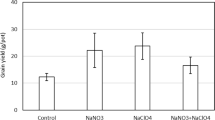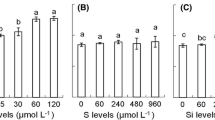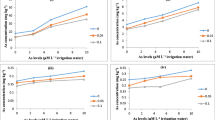Abstract
In this study we have investigated the uptake and distribution of arsenic (As) and phosphate (Pi) in roots, shoots, and grain of wheat grown in an uncontaminated soil irrigated with solutions containing As at three different concentrations (0.5, 1 and 2 mg l−1) and in the presence or in the absence of P fertilization. Arsenic in irrigation water reduced plants growth and decreased grain yield. When Pi was not added (P−), plants were more greatly impacted compared to the plus Pi (P+) treatments. The differences in mean biomass between P− and P+ treatments at the higher As concentrations demonstrated the role of Pi in preventing As toxicity and growth inhibition. Arsenic concentrations in root, shoot and grain increased with increasing As concentration in irrigation water. It appears that P fertilization minimizes the translocation of As to the shoots and grain whilst enhancing P status of plant. The observation that P fertilization minimises the translocation of arsenic to the shoots and grain is interesting and may be useful for certain regions of the world that has high levels of As in groundwater or soils.

Similar content being viewed by others
References
Abedin, M. J., Cresser, M. S., Meharg, A. A., Feldmann, J., & Cotter-Howells, J. (2002). Arsenic accumulation and metabolism in rice (Oryza sativa L.). Environmental Science & Technology, 36, 962–968. doi:10.1021/es0101678.
Bliek, T., Bleeker, P. M., Vooijs, R., Arnetoli, M., & Schat, H. (2008). The role of arsenate reductase in arsenate toxicity and tolerance in plants. Presented in 20th New Phytologist Symposium “Arsenic: Unravelling its metabolism and speciation in plants”, Aberdeen, Scotland, UK.
Burlo, F., Guijarro, L., Carbonell-Barrachina, A. A., Valero, D., & Martinez-Sanchez, F. (1999). Arsenic species: effects on and accumulation by tomato plants. Journal of Agricultural and Food Chemistry, 47, 1247–1253. doi:10.1021/jf9806560.
Carbonell-Barrachina, A. A., Burlò, F., & Mataix, J. (1995). Arsenic uptake, distribution, and accumulation in tomato plants—Effect of arsenite on plant growth and yield. Journal of Plant Nutrition, 18, 1237–1250.
Carbonell-Barrachina, A. A., Burlo, F., Burgos-Hernandez, A., Lopez, E., & Mataix, J. (1997). The influence of arsenite concentration on arsenic accumulation in tomato and bean plants. Scientia Horticulturae, 71, 167–176. doi:10.1016/S0304-4238(97)00114-3.
Chakrabarti, D., Rahman, M. M., Paul, K., Chowdhury, U. K., Sengupta, M. K., Lodh, D., et al. (2002). Arsenic calamity in the Indian subcontinent. What lessons have been learned? Talanta, 58, 3–22. doi:10.1016/S0039-9140(02)00270-9.
Clark, G. T., Dunlop, J., & Phung, H. T. (2000). Phosphate absorption by Arabidopsis thaliana: Interactions between phosphorus status and inhibition by arsenate. Australian Journal of Plant Physiology, 27, 959–965.
Cox, M. S., & Bell, P. E. (1996). Differential tolerance of canola to arsenic when grown hydroponically or in soil. Journal of Plant Nutrition, 19, 1599–1610.
Dall’Aglio, M. (1995). Problemi emergenti di geochimica ambientale e salute in Italia con particolare riferimento all’arsenico. Atti del II Convegno Nazionale sulla protezione e gestione delle acque sotterranee. Metodologie, tecnologie e obiettivi. Modena, volume 4 quaderno Geologia Applicata 1, gennaio-giugno 1996, pp. 85–95.
Dall’Aglio, M. (2006). Alte concentrazioni di arsenico nel canale di Piombino e sulle coste elbane. Green report.it.
Dahal, B. M., Fuerhacker, M., Mentler, A., Shrestha, R. R., & Blum, W. E. H. (2008). Screening of arsenic in irrigation water used for vegetable production in Nepal. Archives of Agronomy and Soil Science, 54, 41–51. doi:10.1080/03650340701628197.
Duxbury, J. M., Mayer, A. B., Lauren, J. B., & Hassan, N. (2002). Arsenic content of rice in Bangladesh and its impacts on rice productivity. Presented in 4th Annual Conference on Arsenic Contamination in Groundwater in Bangladesh: Cause, Effect and Remedy, Dhaka, Bangladesh.
Fitz, W. J., & Wenzel, W. W. (2002). Arsenic transformation in the soil–rhizosphere–plant system: Fundamentals and potential application to phytoremediation. Journal of Biotechnology, 99, 259–278. doi:10.1016/S0168-1656(02)00218-3.
Frankenberger, W. T., Jr. (Ed.). (2002). Environmental chemistry of arsenic. New York: Marcel Dekker, p. 391.
Geng, C. N., Zhu, Y. G., Hu, Y., Williams, P., & Meharg, A. A. (2006b). Arsenate causes differential acute toxicity to two P-deprived genotypes of rice seedlings (Oryza sativa L.). Plant and Soil, 279, 297–306. doi:10.1007/s11104-005-1813-7.
Geng, C. N., Zhu, Y. G., Tong, Y. P., Smith, S. E., & Smith, F. A. (2006a). Arsenate (As) uptake by and distribution in two cultivars of winter wheat (Triticum aestivum L.). Chemosphere, 62, 608–615. doi:10.1016/j.chemosphere.2005.05.045.
Hanada, S., Nakano, M., Saitoh, H., & Mochizuki, T. (1975). Studies on the pollution of apple orchard surface soils and its improvement in relation to inorganic spray residues. I. Bulletin of the Faculty of Agriculture, Hirosaki University, 25, 13–17.
Hartley-Whitaker, J., Ainssworth, G., & Meharg, A. A. (2001). Copper and arsenate-induced oxidative stress in Holcus lanatus L. clones with differential sensitivity. Plant, Cell & Environment, 24, 713–722. doi:10.1046/j.0016-8025.2001.00721.x.
Indorante, S. J., Follmer, L. R., Hammer, R. D., & Koenig, P. G. (1990). Particle-size analysis by a modified pipette procedure. Soil Science Society of America Journal, 54, 560–563.
Jiang, Q. Q., & Singh, B. R. (1994). Effect of different forms and sources of arsenic on crop yield and arsenic concentration. Water, Air, and Soil Pollution, 74, 321–343.
Lee, D. A., Chen, A., & Schroeder, J. I. (2003). Ars1, an Arabidopsis mutant exhibiting increased tolerance to arsenate and increased phosphate uptake. The Plant Journal, 35, 637–646. doi:10.1046/j.1365-313X.2003.01835.x.
Liu, X., Zhang, S., Shan, X., & Zhu, Y. G. (2005). Toxicity of arsenate and arsenite on germination seedling growth and amylolytic activity of wheat. Chemosphere, 61, 293–301. doi:10.1016/j.chemosphere.2005.01.088.
Mandal, B. K., & Suzuky, K. T. (2002). Arsenic round the world: a review. Talanta, 58, 201–235. doi:10.1016/S0039-9140(02)00268-0.
Meharg, A. A. (1994). Integrated tolerance mechanisms constitutive and adaptive plant responses to elevated metal concentrations in the environment. Plant, Cell & Environment, 17, 989–993. doi:10.1111/j.1365-3040.1994.tb02032.x.
Meharg, A. A. (2005). Mechanism of plant resistance to metal and metalloid ions and potential biotechnological applications. Plant and Soil, 274, 163–174. doi:10.1007/s11104-004-0262-z.
Meharg, A. A., & Hartley-Whitaker, J. (2002). Arsenic uptake and metabolism in arsenic resistant and non resistant plant species. The New Phytologist, 154, 29–43. doi:10.1046/j.1469-8137.2002.00363.x.
Meharg, A. A., & Macnair, M. R. (1991). The mechanisms of arsenate tolerance in Deschampsia cespitosa (L.) Beauv and Agrostis capillaris L. The New Phytologist, 119, 291–297. doi:10.1111/j.1469-8137.1991.tb01033.x.
Meharg, A. A., & Macnair, M. R. (1992). Suppression of the high affinity phosphate uptake system a mechanism of arsenate tolerance in Holcus lanatus L. Journal of Experimental Botany, 43, 519–524. doi:10.1093/jxb/43.4.519.
Meharg, A. A., Naylor, J., & Macnair, M. R. (1994). Phosphorus nutrition of arsenate-tolerant and nontolerant phenotypes of velvet grass. Journal of Environmental Quality, 23, 234–238.
Meharg, A. A., & Rahman, M. M. (2003). Arsenic contamination of Bangladesh paddy field soils: implication for rice contribution to arsenic consumption. Environmental Science & Technology, 37, 229–234. doi:10.1021/es0259842.
Paliouris, G., & Hutchinson, T. C. (1991). Arsenic, cobalt and nickel tolerances in two populations of Silene vulgaris (Moench) Garcke from Ontario, Canada. The New Phytologist, 117, 449–459. doi:10.1111/j.1469-8137.1991.tb00009.x.
Peryea, F. J. (1998). Phosphate starter fertilizer temporarily enhances soil arsenic uptake by apple trees grown under field conditions. Horticultural Science, 33, 826–829.
Quaghebeur, M., & Rengel, Z. (2003). The distribution of arsenate and arsenite in shoots and roots of Holcus lanatus is influenced by arsenic tolerance and arsenate and phosphate supply. Plant Physiology, 132, 1600–1609. doi:10.1104/pp.103.021741.
Rahman, M. A., Hasegawa, H., Rahman, M. M., Rahman, M. A., & Miah, M. A. M. (2007). Accumulation of arsenic in tissues of rice plant (Oryza sativa L.). Chemosphere, 69, 942–94. doi:10.1016/j. Chemosphere.2007.05.044.
Roychowdhury, T., Tokunaga, H., Uchino, T., & Masanori, A. (2005). Effect of arsenic-contaminated water on agricultural land soil and plants in West Bengal, India. Chemosphere, 58, 799–810. doi:10.1016/j.chemosphere.2004.08.098.
Singh, N., & Ma, L. Q. (2006). Arsenic speciation, and arsenic and phosphate distribution in arsenic hyperaccumulator Pteris vittata L. and non-hyperaccumulator Pteris ensiformis L. Environmental Pollution, 141, 238–246. doi:10.1016/j.envpol.2005.08.050.
Small, H. G., & McCants, C. B. (1962). Influence of arsenic applied to the growth media on the arsenic content of fluecured tobacco. Agronomy Journal, 54, 129–133.
Smedley, P. L., & Kinniburgh, D. G. (2002). A review of the source, behaviour, and distribution of arsenic in natural waters. Applied Geochemistry, 17, 517–568. doi:10.1016/S0883-2927(02)00018-5.
Smith, E., Naidu, R., & Alston, A. M. (1998). Arsenic in the soil environment: A review. Advances in Agronomy, 64, 149–195. doi:10.1016/S0065-2113(08)60504-0.
Sneller, E. F. C., Van Heerwaarden, L. M., Kraaijeveld-Smit, F. J. L., Ten Bookum, W. M., Koevoets, P. L. M., Schat, H., et al. (1999). Toxicity of arsenate in Silene vulgaris, accumulation and degradation of arsenate induced phytochelatins. The New Phytologist, 144, 223–232. doi:10.1046/j.1469-8137.1999.00512.x.
Tao, Y., Zhang, S., Yuan, W. J., & Shan, X. Q. (2006). Effect of oxalate and phosphate on the release of arsenic from contaminated soils and arsenic accumulation in wheat. Chemosphere, 65, 1281–1287. doi:10.1016/j.chemosphere.2006.04.039.
Tu, S., & Ma, L. Q. (2003). Interactive effects of pH, arsenic and phosphorus on uptake of As and P and growth on the arsenic hyperaccumulator Pteris vittata L. under hydroponic conditions. Environmental and Experimental Botany, 50, 243–251. doi:10.1016/S0098-8472(03)00040-6.
Ullrich-Erebius, C. I., Sanz, A., & Novacky, A. J. (1989). Evaluation of arsenate and vanadate associated changes of electrical membrane potential and phosphate transporting Lemma gibba G1. Journal of Experimental Botany, 40, 119–128. doi:10.1093/jxb/40.1.119.
Violante, A., & Pigna, M. (2002). Competitive sorption of arsenate and phosphate on different clay minerals and soils. Soil Science Society of America Journal, 66, 1788–1796.
Violante, A., Pigna, M., & Del Gaudio, S. (2005). Adsorption–desorption processes of arsenate in soil environments. In P. M. Huang, J.-M. Bollag, A. Violante, & P. Vityakon (Eds.), Soil abiotic & biotic interactions and the impact on the ecosystem & human welfare (pp. 269–299). Enfield, NH, USA: Science Publishers.
Williams, P. N., Price, A. H., Raab, A., Hossain, S. A., Feldmann, J., & Meharg, A. A. (2005). Variation in arsenic speciation and concentration in paddy rice related to dietary exposure. Environmental Science & Technology, 39, 5531–5540. doi:10.1021/es0502324.
Williams, P. N., Villana, A., Deacon, C., Raab, A., Figuerola, J., Green, A. J., et al. (2007). Greatly enhanced arsenic shoot assimilation in rice leads to elevated grain levels compared to wheat and barley. Environmental Science & Technology, 41, 6854–6859. doi:10.1021/es070627i.
Zavatti, A., Attramini, D., Bonazzi, A., Boraldi, V., Malaga, R., Martinelli, G., et al. (1995). La presenza di arsenico nelle acque sotterranee della Pianura Padana: evidenze ambientali e ipotesi geochimiche. Atti del II Convegno Nazionale sulla protezione e gestione delle acque sotterranee. Metodologie, tecnologie e obiettivi. Nonantola (MO), vol 2 quaderni Geologia Applicata 1, gennaio-giugno 1996, pp. 2301–2324.
Zhao, F. J., Lopez-Bellido, F. J., Gray, C. W., Whalley, W. R., Clark, L. J., & McGrath, S. P. (2007). Effects of soil compaction and irrigation on the concentrations of selenium and arsenic in wheat grains. The Science of the Total Environment, 372, 433–439. doi:10.1016/j.scitotenv.2006.09.028.
Acknowledgements
This work was supported by the Italian Research Program of National Interest (PRIN2006). DiSSPAPA contribution no 172.
Author information
Authors and Affiliations
Corresponding author
Rights and permissions
About this article
Cite this article
Pigna, M., Cozzolino, V., Violante, A. et al. Influence of Phosphate on the Arsenic Uptake by Wheat (Triticum durum L.) Irrigated with Arsenic Solutions at Three Different Concentrations. Water Air Soil Pollut 197, 371–380 (2009). https://doi.org/10.1007/s11270-008-9818-5
Received:
Accepted:
Published:
Issue Date:
DOI: https://doi.org/10.1007/s11270-008-9818-5




